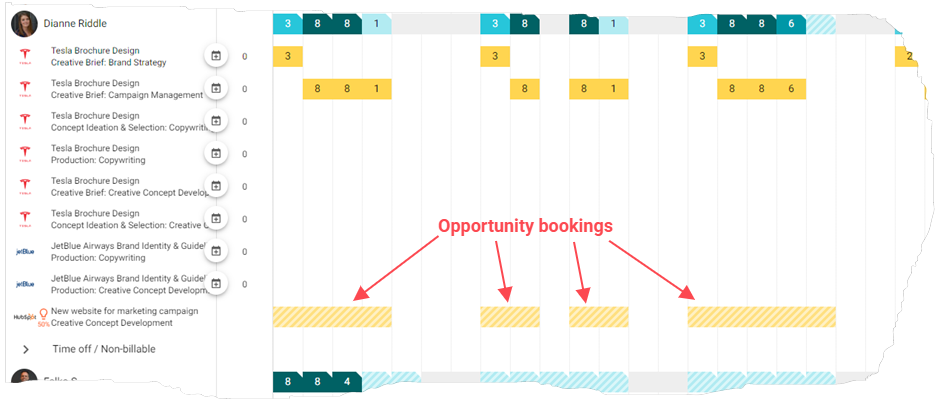Bookings
A booking represents the complete planning and commitment of resources for an opportunity. This is a preliminary step that helps prepare for the successful conversion of the opportunity into a project.
A booking consists of two phases:
-
Defining the potential activity and resource requirements for the opportunity, known as the demand line. A booking can have more than one demand line.
-
Populating the demand lines with actual resources who have the skill and experience to complete the activity as the opportunity matures and approaches the potential win stage.
Bookings help to optimize resource allocation and management by detailing the specific project requirements of an opportunity, including workforce needs and skill levels. Bookings reduce the complexity of managing multiple potential opportunities, thereby streamlining operational processes and improving efficiency.
Why bookings
For sales and account managers, knowing the demand of potential projects—currently tracked as opportunities—is invaluable. Bookings provide a forward-looking view of the activities and skills that will be required if these opportunities convert into actual projects.
Insights into the gap
One of the most critical insights 'Opportunity Bookings' offers is the visualization of the 'gap' between current resources and the demands of prospective projects. It answers pressing questions about resource availability and the need for additional hiring. With bookings, managers can:
-
Predict the volume and type of resources needed for future projects.
-
Assess the current workforce’s capacity to meet upcoming demands.
-
Identify when and where there is a shortfall of skills or personnel.
Preventing bench time
By accurately forecasting resource needs, VOGSY aims to prevent bench time—the underutilization of staff due to a lack of work. This not only maximizes the efficiency of the workforce but also contributes to better financial health for the company by reducing unnecessary payroll expenses.
Resource Allocation Queries
A fundamental question that bookings can help to answer is: "Can I resource my future project with the current team, or do I need to hire more resources?" This foresight facilitates better workforce management and strategic planning, ensuring that you are always one step ahead in your resource planning strategies.
Simplifying future project planning
Bookings simplify the planning of future projects. It allows you to set up potential project parameters without the need to create a 'real' project. This eases the transition from a lead to a project by having all the groundwork in place, ready to be activated once the opportunity is won.
Key components of a booking
A booking contains a list of the activities that will be required to complete the associated project.

Each activity has the following components:
|
Expect start and finish dates of the opportunity. |
|
Number of Full Time Employees (FTEs) required for the potential project. |
|
Click this button to add an activity and its requirements to this booking. |
|
Activity required to complete the potential project. |
|
The seniority level required to complete the activity. |
|
Skills and skill levels that the resources must possess in order to complete the activity. |
|
Number of Full Time Employees (FTEs) required to complete the activity. An FTE equals 40 hours. |
|
Click to open the activity’s edit screen. |
|
Resources that are assigned to the activity. |
|
Available FTE hours that are not yet booked. |

The resource badge contains the following elements:
|
The name and profile photo of the resource. |
|
The amount of FTEs assigned to the resource for the activity. An FTE equals 40 hours. |
|
The seniority level of the resource. |
Bookings search view
The Opportunities search view has a specialized layout for viewing all (or a filtered subset) active bookings and their demand lines. It’s a quicker way to learn at a glance about the work and resource requirements of an opportunity.

Create a booking
Creating a booking involves two phases, each of which will most likely be completed by different people at different points in the opportunity cycle.
The first phase involves defining the potential activity and resource requirements for the opportunity. In VOGSY, this is called the demand.
As the opportunity becomes more mature and approaches the potential win stage, the demands can be populated with resources who have the skill and experience to complete the activity. This is the second phase and constitutes a complete booking.
Make sure that the opportunity has an Expected start date and an Expected finish date for the potential project that might result from a successful opportunity, otherwise the booking’s dates will not display in the Resource planning view.
|
Create a demand line
-
Open the opportunity and click Bookings. The Opportunity bookings screen opens.

-
Click Add Activity. The Add activity and bookings screen opens.
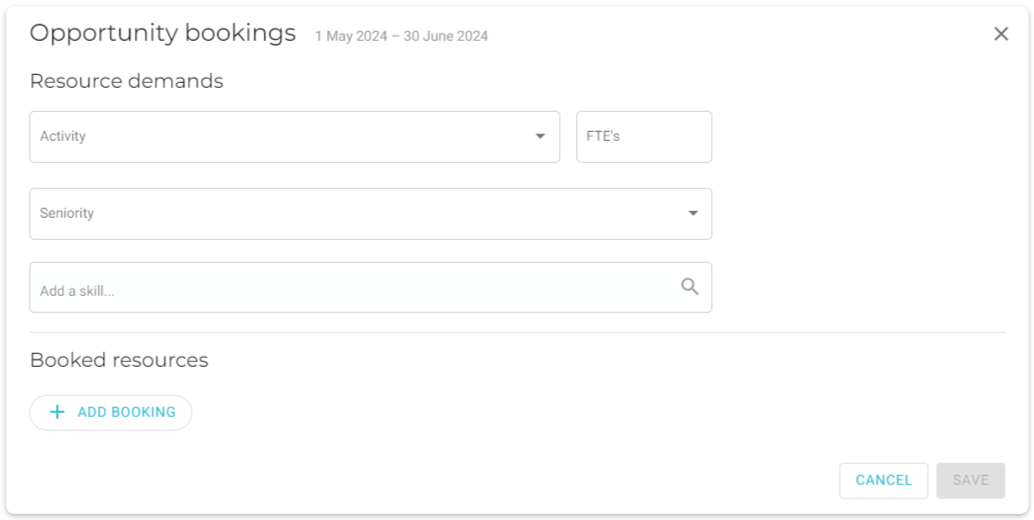
-
Fill out the Activity, FTEs, Seniority, and Skills fields.

An FTE equals 40 hours of work. Half (.5) of an FTE equals 20 hours of work. VOGSY can handle decimal numbers in the FTE field.
Note the following:
-
The items in the Activity drop-down list are taken from the Activity master table, which can be updated in the back office.
-
The items in the Seniority drop-down list are taken from the Seniorities master table, which can be updated in the back office.
-
The items in the Add a skill drop-down list are taken from the Skills master table, which can be updated in the back office.
-
-
Click Save and the demand will be added to the Opportunity bookings page.

-
Add as many demand lines as necessary to fully support the potential project that might result from this opportunity.
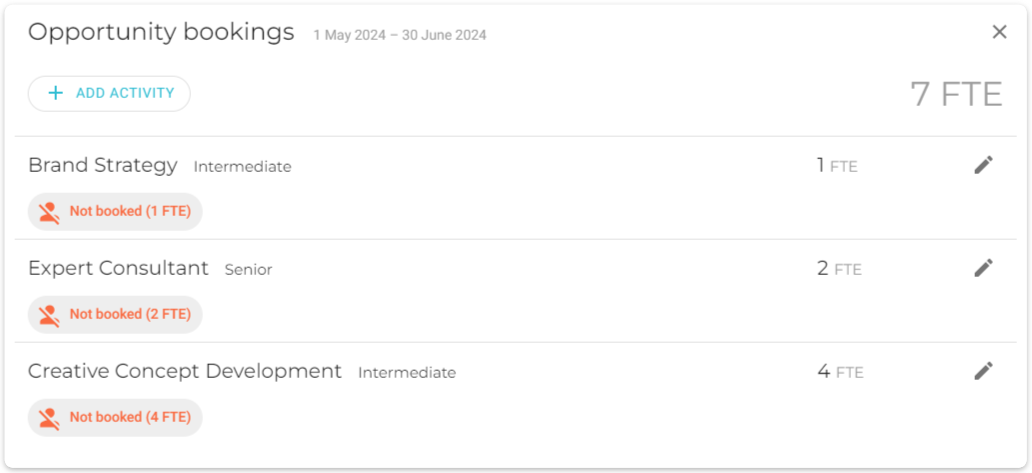
Add resources to a demand
-
Go to the opportunity and click Bookings.
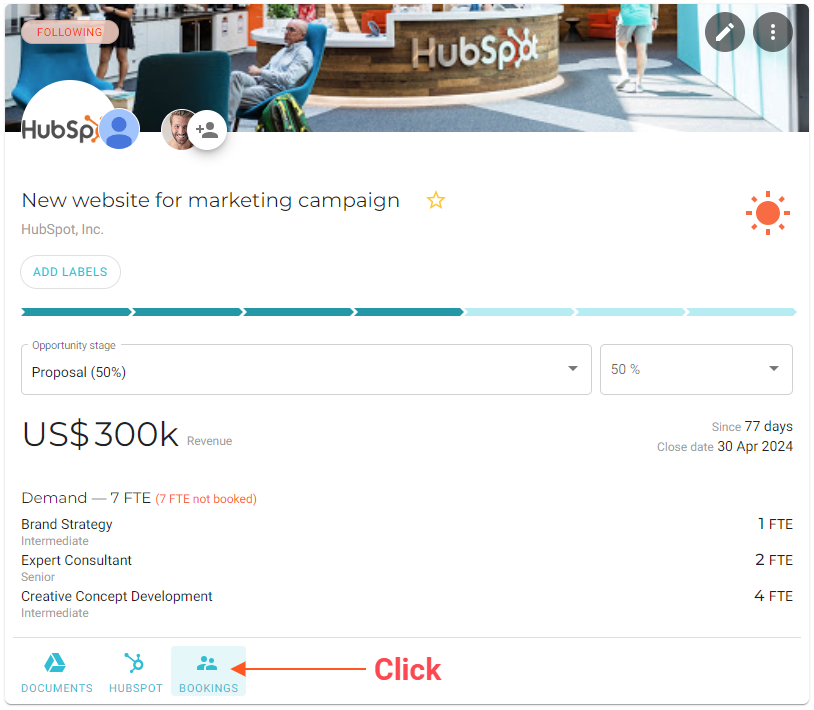
The Opportunity bookings page displays.

-
Click the
 for the demand that you want to add resources to. The Opportunity bookings page changes to display the Resource demands and Booked resources sections.
for the demand that you want to add resources to. The Opportunity bookings page changes to display the Resource demands and Booked resources sections.
-
Click the Add Booking button. A Find a resource page displays. The filter will already be populated with the choices you made in the Resource demands section. If there are any matches, they will desplay in the Results section.

-
If the appropriate resources display in the Results section, select them and click Add. The resource will be added to the Booked resources section of the Opportunity bookings page.
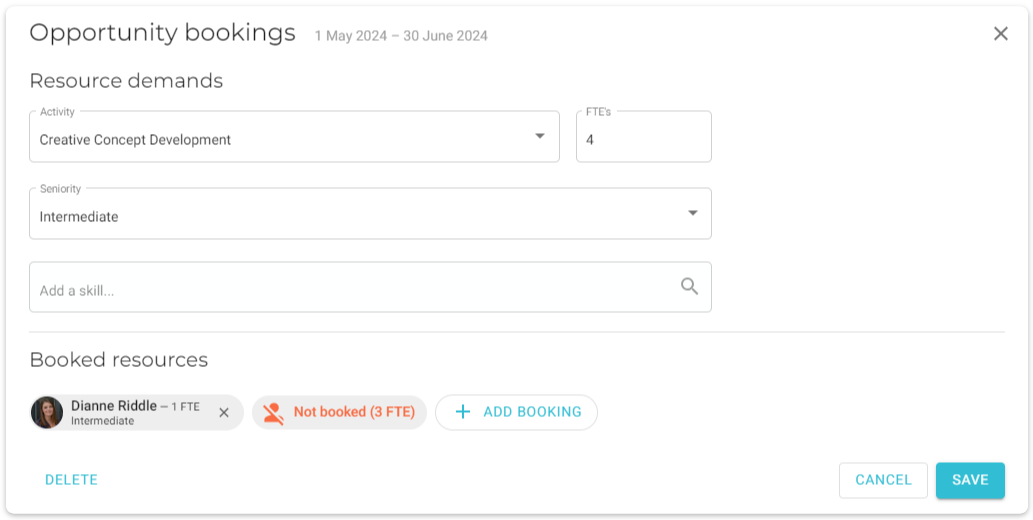
If the resources’ hours are available, VOGSY will distribute the FTEs (remember, an FTE equals 40 hours) evenly amongst the resources that you select. Otherwise VOGSY will add as many FTEs as the resource’s hours permit. -
If there are no results, or if the appropriate resource doesn’t display in the Results section, you can adjust the filter criteria until the resources display. Or if you know the name of an appropriate resource, you can put that name in the Filter on resource name field. If the appropriate resource displays in the Results section, select them and click Add.

If, despite your adjustments, you can not find the appropriate resource, that is a sure sign that you might need to hire new resources for this potential project. -
Click Save to complete the booking.
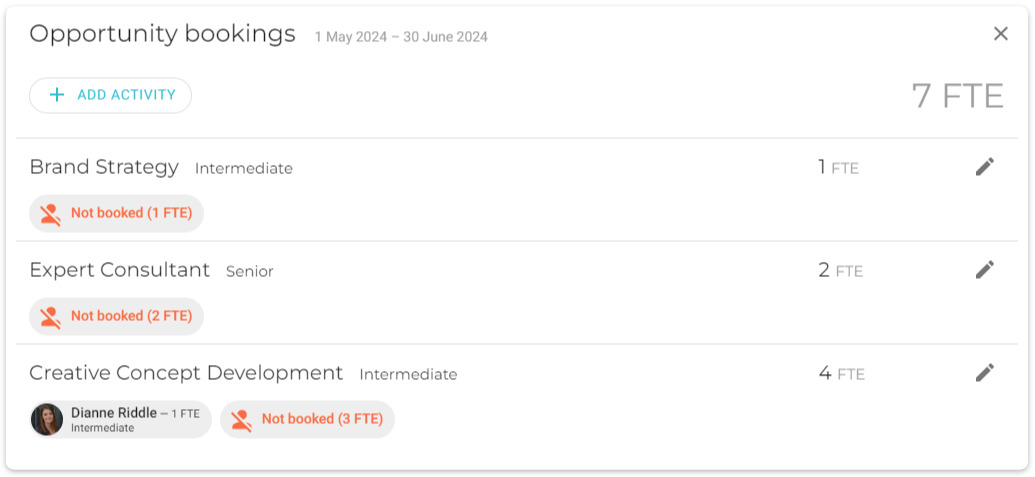
The booking can also be viewed in the resource planning.
